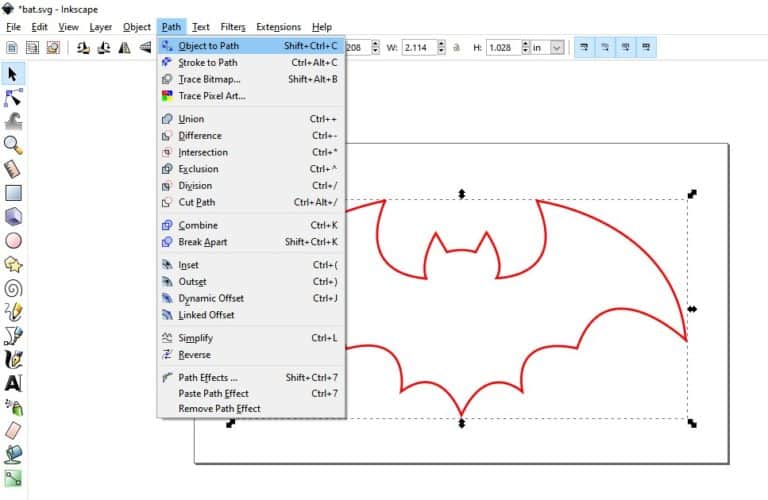

This does not happen for "Path by Path" or "Pass by Pass".Ĥ) Setting units to "in" instead of "mm" under Preferences does not seem to have any effect.Įdit: I think I have figured this out, it seems the measurement scale is in inches if the "Orientation" scale is in inches - is this correct? However, if I copy the paths and paste into the same location with ctrl-C then ctrl-alt-V (no other manipulations), Path to Gcode runs normally with no error messages and produces good output.ģ) If I run Path to Gcode with cutting order "Subpath by Subpath", the coloured paths generated look normal, but the actual gcode output contains 7 replicates of the edge-most path, and no cuts in between (so it mills the perimeter correctly, but does not mill out any other material). this is repeated 7 times, one for each path line, and the output file contains no gcode. Warning: One or more paths do not have 'd' parameter, try to Ungroup (Ctrl+Shift+G) and Object to Path (Ctrl+Shift+C)! Not a problem as long as I set the "Area width" exactly to the right number though, only if I make it too big.Ģ) Once the area tool has run, if I select the resuling paths and run "Path to Gcode", I get an error message: These result in the cutter running along the edge of the area, so the result is 1/2 cutter width "extra" is cut out at all edges. If I set "Area width" to 10, an extra 3 outlines are made at the perimeter (both outside and around the inner hole). Ive experimented with changing the stroke width which doesnt help. So with 0.5 overlap, it will use 7 tool paths to mill the initial shape file (same file as above). Create tool paths via Extensions > Gcodetools > Path to Gcode.

I checked and the number is equal to the difference between the number of tool paths needed to fill in the space, and the number I put under "Area width". Thanks!ġ) When I run the area tool, as I mentioned before I get some "extra" outlines actually on the perimeter that are not tool paths. OK, great - that seems to work fine, I get very nice cut paths out of it. I highly recommend you to try the dev version. There wont be any uncut places and it works without "area artifacts" which are suddenly appear when using path-offset to create area curves. Then a new function has been involved it fills the path with spiral or zig-zag. It is useful to reduce amount of material that is cutting in same time (so you can use weaker routers) and helps to get rid of places. Which defines cutting trajectory overlapping. An overlap parameter has been added to standard Area function.
#INKSCAPE GCODE EXTENSION HOW TO#
How to avoid those uncut places There are some improvements have been made in the Gcodetools-dev version. So thus you'll what will be actually machined. I will try the G-code paths mentioned above, as I am sure there are better Inkscape to G-code generation methods. Found that Inkscape fed into > JScut online (gcode) > CNCjs online fed into 18×30 router/mill. Select all the path's that are forming the trajectory, open fill and stroke dialog (Ctrl+Shift+F), go to the third tab, and set up stroke width equal to your mill's bit width and set up the corners and ending to "round". Anyway, tried a G-Code extension, some ware in Russia, at best did not WORK FOR ME. Thanks and I really appreciate you making this available, I will have a lot of fun with it once I figure out how to use it.įirst of all if you want to see what will be actually cut you can do it straight from Inkscape. the initial boundary path must not cut outside the desired area, but subsequent paths can exceed their target area and overlap with previous cuts, as long as they don't go outside the original boundary).

#INKSCAPE GCODE EXTENSION CODE#
Possibly this is a result of re-using the code that decides where the first boundary is to select subsequent milling paths? (e.g. It looks to me like what is happening is that there are places where the logic cannot mill out the material without part of the cutter intruding into an area that has already been milled, and so it does not do this.

If I set width to 2 mm under Stroke Style in Inkscape, I see the same gaps, so this is not an artefact of the cncSimulator but a problem with the actual gcoded paths. Visual examination of the last block of Gcode (which makes the outermost cut) shows it is correct to within rounding error for a 2 mm cutter. Code is used as it comes out of the extension, but I add "T5" as the first line to specify a 2 mm diameter cutter from my library.


 0 kommentar(er)
0 kommentar(er)
